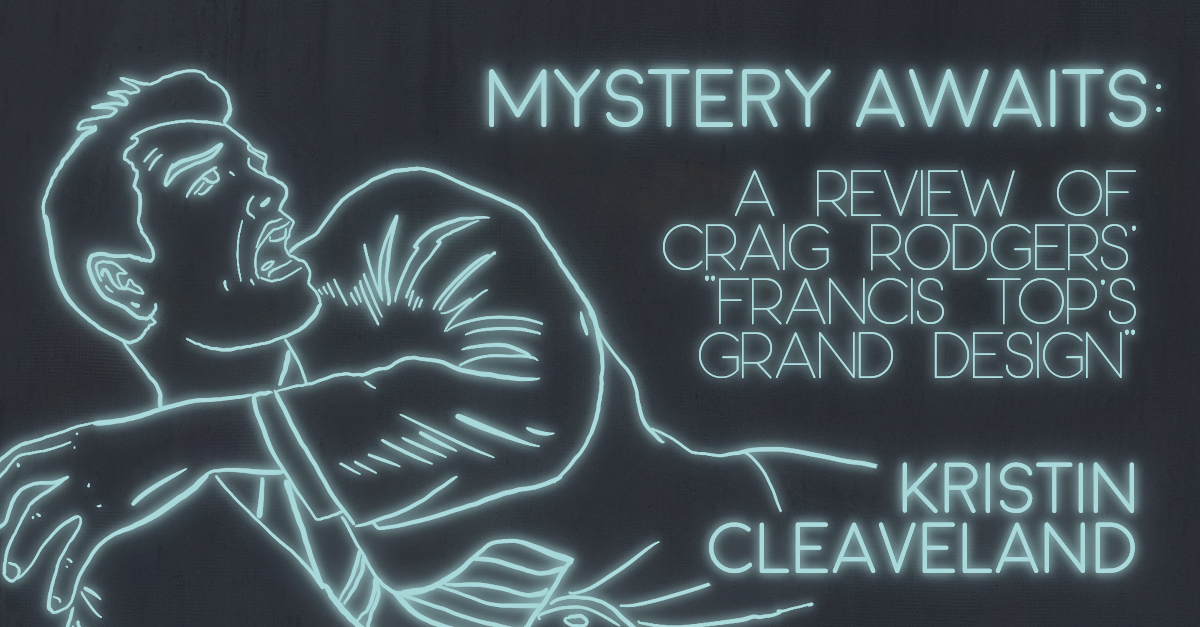In fiction–particularly short fiction, where words must not be wasted and first impressions are crucial–crafting successful ambiguity can be tricky; the author walks a tightrope between leaving the reader feeling pleasantly intrigued and wanting more, or tossing the book aside, unsatisfied. There is a long tradition of the “almost-but-not-quite” reveal lurking between the lines of classic horror tales, from the creeping dread of Shirley Jackson’s “The Summer People” to the quietly dawning terror of Robert Aickman’s “The Hospice.” Craig Rodgers, who has cited both these authors as influences on his work, pulls off this literary sleight-of-hand effectively throughout his newest collection of quietly uncanny short fiction, Francis Top’s Grand Design.
Released in June 2022, Francis Top’s Grand Design features twelve stories—some on the longer side, some as brief as one page—that quietly explore themes of loneliness, mystery, and longing for something unseen and perhaps entirely unknowable. Grief, regret, and guilt suffuse these pages; happiness is rarely found, but beauty is woven throughout. Rodgers’ characters drift through life searching, often alone but not always, for something the reader soon realizes they are not likely to find, or even understand if they did. In “Morning Stockton,” two characters discuss journeying to a destination they have only read about in a mysterious and uncanny book. “‘It’s not a real place,’” one says, to which the other replies, “‘That’s what makes it fun. Like jumping headfirst into a dream’” (33).
“Jumping headfirst into a dream” also describes the experience of reading Francis Top’s Grand Design. There is an otherworldly quality to many of these tales, a blurring of edges that gives the impression that the stories’ events take place somewhere between waking and sleeping. An undercurrent of eldritch or cosmic horror runs throughout the collection, particularly in the brief and beautiful tale “The Rails,” in which a mysterious character is described as such: “The suit a deep blue and filthy, the thing’s flesh the pale blue of fish belly or corpse. It hums a little tune in the dark and it takes its pick of the riders arranged about in the car and it does devour the flesh and meat of man, the organs, the life. It dances with its pleasure and its bare feet blacked by filth or by tar or the coals of some trell do move with a rhythm at ease and joyous” (42). As readers, we never encounter this strange creature ourselves; just overhear other characters discussing its potential existence. This sense of watching or listening from afar, of action taking place just off-page, permeates the collection and might prove frustrating to readers accustomed to more action or resolution in their short fiction, but those who appreciate an atmosphere of mystery will likely enjoy it.
Nowhere in this collection is this mysterious atmosphere more prevalent than in “The Lock and the Door,” which introduces readers to the titular Francis Top without letting us in on the ultimate secret of his grand design. Using elements traditional to “mysterious house” stories–a ring of unlabeled keys! A roll-top desk! A sealed room!–Rodgers leads the reader to believe that something macabre, even fantastical is hidden behind the door. And perhaps there is, but we, as readers, will remain in the dark, even while the story’s hero makes the discovery. Maybe what is behind the door is too terrible to contemplate; there is a Lovecraftian hint of madness about it, perhaps also a Ligottian element of carnival. Rodgers acts as barker, calling to his readers: “Look, Look! The Grand Design! The Lock! The Door!” then through a deft bit of sideshow magic leaves us even more puzzled than before we paid the price of admission. We do not feel cheated, though; more pleasantly bemused. “Next time,” we think. “Next time, we’ll find it.” And then, we turn the page.

